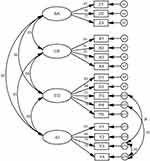Back to Journals » Psychology Research and Behavior Management » Volume 15
Analysis of Concept Construction and Scale Development of Employee Zhengchong Behaviour in Family Firms in Jiangsu Province of China
Authors Ma Z, Fan M, Ouyang C , Su J , Wu M
Received 25 June 2022
Accepted for publication 8 September 2022
Published 22 September 2022 Volume 2022:15 Pages 2717—2734
DOI https://doi.org/10.2147/PRBM.S380050
Checked for plagiarism Yes
Review by Single anonymous peer review
Peer reviewer comments 2
Editor who approved publication: Dr Igor Elman
Zejun Ma,1 Ming Fan,1 Chenhui Ouyang,1 Jialu Su,1 Mengyun Wu2
1School of Management, Jiangsu University, Zhenjiang, People’s Republic of China; 2School of Finance & Economics, Jiangsu University, Zhenjiang, People’s Republic of China
Correspondence: Mengyun Wu, Tel +86 15905288730, Email [email protected]
Purpose: Some scholars have explored the connotation and structural elements of employee zhengchong behaviour based on Taiwan’s local enterprises, providing results with reference significance. However, there is a lack of accurate measurement scales. How to treat employee zhengchong behaviour (striving for a favour) and effectively deconstruct it is very important to the sustainable development of family firms.
Methods: Semistructured interviews were conducted with 62 employees of private enterprises, and the structural dimension of employee zhengchong behaviour was explored with the help of grounded theory. The researchers designed two questionnaires, collected 278 and 331 valid questionnaires in the two surveys, compiled the corresponding measurement scale, and tested it.
Results: Employee zhengchong behaviour under differential leadership was a multidimensional structure with rich connotations consisting of four dimensions: showing abilities, collaborating and sharing, excluding outsiders, and ingratiating upwards. The scale includes 16 items.
Conclusion: This study enriches the relevant theories while providing a decision reference for family firm leaders to guide employee zhengchong behaviour to reasonably improve firm performance.
Keywords: family firms, differential leadership, grounded theory, scale development
Introduction
Whether in developed countries or developing countries, family firms are surviving and developing tenaciously. Due to the influence of traditional culture, Chinese family firms are more susceptible to the psychological influence of “insiders” and “outsiders” and adopt different treatment methods for different employees.1 Leadership has long been considered a critical factor in achieving team and organizational goals.2 Leadership style affects and guides the choice of employee behaviour and significantly impacts the survival and development of enterprises.3
Previous studies have shown that the particularism or rule by man in Chinese culture urges leaders to give more favouritism to their preferred subordinates and adopt different leadership behaviours.4 This unique leadership style is called differential leadership, which is particularly common in family firms.5 Many scholars believe that this leadership style is rooted in Confucian thought and Legalist thought in Chinese traditional culture. It has a unique role in management practice and a profound impact on the operation of Chinese family firms.6 Differential leadership divides employees into “insiders” and “outsiders”. “Insiders” refers to the employees seeking favour from their managers and becoming favoured subordinates, while “outsiders” do not do such things. Then, the former are seen as those with high performance and job satisfaction. As a result, the differential treatment by leaders results in uneven resource distribution, leading team members to compete to improve their status by seeking favour from their leaders.
Huang,7 a scholar from Taiwan Province, put forward the concept of zhengchong behaviour to explore such interactive behaviour among employees and defined zhengchong behaviour as the phenomenon in which employees fawn on leaders and woo or crowd out colleagues to gain the favour of leaders. “Competing” is purposeful behaviour, while “favour” refers to the gifts and attention from leaders to employees. To compete for resources or rights, employees adopt different strategies in the process of zhengchong, which may not only promote the improvement of their own or team performance but also lead to the depletion of internal resources. Take the family firm “True Kung Fu” as an example (the leading enterprise in China’s fast-food industry); the struggle between “insiders” caused by “defamiliarization” has led to poor business management.8–10 In contrast, “Fangtai” (a well-known kitchenware brand in China), as a typical successful representative of a family firm, adheres to the management concept of meritocracy and continues to promote the enthusiasm of all employees.11 For enterprises, the organizational phenomenon of zhengchong behaviour has a significant impact on their long-term development, especially in the atmosphere of differential leadership. The in-depth discussion of zhengchong behaviour is of great significance.
Some scholars in Taiwan Province have explored the connotation and structural elements based on Taiwan’s local enterprises with qualitative analysis, such as Huang7 and Huang,12 providing results with reference significance. However, given the geographical differences and different research paradigms, the existing research on the dimensions of employee zhengchong behaviour has more powerful subjectivity and insufficient systematicity, and there is a lack of accurate measurement scales.7 In addition, the lack of research on employee zhengchong behavior throughout the Chinese mainland also limits the development of related fields of study. Thus, identifying the dimensions of employee zhengchong under differential leadership as well as developing a zhengchong scale based on empirical measurement can enrich the current research and contribute significantly to the Chinese study of management style, which plays an essential role in guiding the development of enterprises.
The study is organized as follows. The researchers summarize the related literature in the Conceptual Analysis section. The researchers introduce the conceptual model construction of employee zhengchong behaviour in detail based on the qualitative research method of grounded theory in the Exploratory Research on the Structural Dimension of Employee Zhengchong Behaviour section. The researchers verify the dimensions developed by exploratory factor analysis and confirmatory factor analysis in the Conceptual Constructs of Employee Zhengchong Behaviour section. The researchers offer a discussion of their theoretical contributions and practical enlightenments and conclude the paper in the Discussion and Conclusion sections.
Conceptual Analysis
The Connotation of Employee Zhengchong Behaviour
When the word “zhengchong” is mentioned, a corresponding scene occurs to most of us, which indicates that zhengchong is not uncommon in real life. What is “zhengchong”? Before 2009, no scholar specifically mentioned the concept of “striving for a favour”, but related research has paved its way. Some studies have pointed out that leaders tend to rule by man, so managers are influenced by human feelings or relationships when making decisions. At the same time, subordinates try to cater to the wants and preferences of their leaders and are eager to obtain available resources from their managers and satisfy their personal needs. In the scope of organizational behaviour research, some scholars have pointed out the concepts of ingratiation and political skill behaviour,5 which is similar to the concept of rivalry. Ingratiation is a strategic behaviour to influence specific others and increase their attraction to the target. Political skill behaviour is a process of exerting social influence. Through political behaviour, short-term or long-term personal interests are maximized, sometimes consistent with others and sometimes in conflict.13 Huang first produced the concept of zhengchong behaviour in 2009 and defined it as an action taken by subordinates to improve their position in their supervisor’s mind. It is pointed out that “favour” is a resource that refers to the position of employees in the leader’s heart in enterprises.12,14,15 When employees flatter leaders, the primary purpose is to gain the leaders’ “pampering”. Therefore, “zhengchong behaviour” can be defined as subordinates’ “flattery”, “infighting”, or “collaboration” of horizontal relationships to gain the leaders’ favour. Compared with ingratiation and political skill behaviour, the goal of zhengchong behaviour is more clearly aimed at flattering leaders and uniting or marginalizing colleagues.
Dimension Division of Employee Zhengchong Behaviour
Considering the division of the dimension of zhengchong behaviour, Huang7 pointed out that the phenomenon of zhengchong behaviour can be divided into “flattery to supervisors” and “cocompetition with colleagues” and conducted an exploratory analysis with grounded theory. In the process of zhengchong behaviour, the leading interactive objects of zhengchong behaviour are their leaders, imaginary enemies, and outsiders, and the interaction with the competition for favour and leaders is manifested in close relationships, loyalty, and talent. The interaction between favoured employees and imaginary enemies is characterized by hostile exclusion, relational attacks, and competition over collaboration. The interaction between favoured employees and outsiders is characterized by attachment, strategic alliances, and collaboration between competitors. On this basis, Huang12 further divided competition behaviour into four main dimensions: pleasing leaders and showing off, flattering and serving, suppressing competitors, and uniting others among enterprises in Taiwan Province.
Although there are some variations in the manifestation of employee zhengchong behaviour, the available research focuses primarily on two aspects: “flattering leaders” and “competing with colleagues.” Furthermore, in terms of the geographical breadth of the research, the extant literature is primarily focused on Taiwan Province. In addition, the majority of research on the components of employee zhengchong behaviour is qualitative, there is no consistent and authoritative scale for assessing employee zhengchong behaviour, and there is a dearth of relevant research on mainland China.
Conceptual Constructs of Employee Zhengchong Behaviour
Research Methods
Grounded theory aims to probe the core concepts reflecting social phenomena and the relationships between concepts through coding and establishing theories based on primary data. It is a bottom-up inductive research method. By coding and analysing the data from multiple sources, the researchers can gradually sum up the explanation of the research phenomenon and develop the foundation of theoretical construction, which is especially suitable for exploratory research in newer fields.16 At present, there is little literature defining “employee zhengchong behaviour”, and the measurement of employee zhengchong behaviour has not yet formed a unified and mature scale. Therefore, this study, based on in-depth interviews, collects and summarizes a large number of interview materials and, on this basis, makes a systematic analysis of “employee zhengchong behaviour”. This research problem belongs to “exploratory research”, which is consistent with the function and essence of grounded theory. The application process of grounded theory mainly includes open coding, axial coding, selective coding and theory saturation testing.
Sample Selection
Employee zhengchong behaviour is manifested as a process interaction among employees or between leaders and employees. It is necessary to obtain research materials from the perspectives of multiple subjects when deconstructing the concept. Therefore, this study obtained interview data through in-depth interviews with multiple subjects, including employees and leaders, when selecting the sample. Meanwhile, considering that the human resource manager (HRM) is the core manager of staff management who has deeper insight into employee zhengchong behaviour, this study also took HRMs as the interview subjects to form an employee–leader–HRM triangle chain of evidence.
After identifying the interviewees, this study, based on sample accessibility and representativeness principles, selected 20 family firms in Jiangsu Province for interviews. The researchers selected these firms for two reasons: first, due to geographical restrictions and the epidemic, the researchers could select only surrounding cities for their research; second, Jiangsu, as one of the more developed provinces in China, has gathered a large number of small and medium-sized enterprises, so the region was able to meet our sample needs. The sample firms came from various industries, including manufacturing, service, and IT, and the size of the firms varied, further enhancing the study’s comprehensiveness. Twenty-two employees, 20 leaders, and 20 HRMs were interviewed. The 62 interviewees were coded in sequence. For example, the researchers interviewed one employee, his leader, and one HR manager of a company in Nanjing. Then, the researchers coded them as A1, A2, and A3 in turn.
Moreover, the researchers coded each of the 62 interviewees individually. Interviewees from the same company were coded. Respondents from the same firm were coded with the same letter and different numbers.
Before the interview, it was necessary to draw up an interview outline. The questions in the outline mainly included “What do you think employee zhengchong is?”, “What are the specific behaviours of employee zhengchong (self-expression to leaders, colleagues, etc.)?”, “How do you view employee zhengchong behaviour (positive/negative, right business impact, impact employees)?” and so on. During the interview process, the semistructured interviews were mainly conducted around the proposed outline. After asking for the interviewer’s consent, the researchers recorded the interviews during the whole process. Then, the recorded information was converted into text information in a word-for-word draft, which laid the foundation for the coding analysis, model building, and theoretical saturation testing.
Results of the Concept Construction
This study borrows Chen’s practice and carries out data analysis following the steps of open coding, spindle coding, and selective coding.17
Open Coding
In applying grounded theory, open coding means that researchers arrange interview records, analyse and summarize these records, and finally sum up the corresponding categories. When gathering and analysing the collected data, researchers must maintain a rational and scientific attitude, seek truths from facts, and reject the influence of subjective consciousness on the original data to the greatest extent, so the original words of interviewees should be used as much as possible. This study retrieved 1800 original sentences and associated concepts using frequency statistics and the encoded interview materials. It was determined that 1480 original sentences and their related concepts could be retrieved after discussing and revising coding errors among different staff members. On this basis, further classification and integration were made, and the initial concepts that appeared more than three times were selected. In this paper, 24 initial concepts and 12 initial categories were obtained. This paper presents 41 typical representative original sentences, as shown in Table 1.
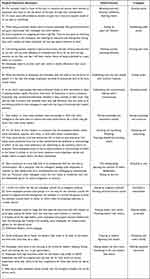 |
Table 1 Examples of Interview Records and Open Coding |
Spindle Coding
Spindle coding is a further analysis of the initial concepts and categories. It tries to find the logical relationships between categories and then sums up the main categories. After many discussions and analyses produced by the research group, 24 original concepts and 12 initial categories of open coding were classified, and four main categories were obtained, namely, showing abilities, collaborating and sharing, excluding outsiders, and ingratiating upwards, as shown in Table 2.
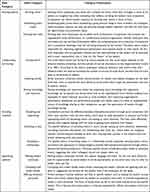 |
Table 2 Spindle Coding |
Selective Coding
Selective coding further analyses and abstracts the concept of the main category in the main axis coding to obtain the relationship between the core category and the main category and extract the related categories. The core category of this study is the competition behaviour of employees, and the main categories include showing abilities, collaborating and sharing, excluding outsiders, and ingratiating upwards. There is a causal relationship between the primary and core categories, thus forming the relationship structure between them.
Based on grounded theory analysis, these two categories are further summarized as positive and negative zhengchong behaviours. Among them, the positive competition behaviours include showing abilities and collaborating and sharing, while the negative competition behaviours include excluding outsiders and ingratiating upwards, as shown in Figure 1.
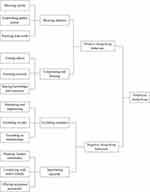 |
Figure 1 Dimensions of employee Zhengchong behaviour. |
Theoretical Saturation Test
Glaser thinks that theoretical saturation means that data are conceptualized and abstracted in categories continuously until new attributes cannot be obtained, so the concept density is produced.16
Therefore, this paper randomly picked two employees of XS Company and ST Company from the list, repeating the open coding stages and initially extracting 120 original sentences and related concepts. For the open coding’s dependability, other scholars were encouraged to examine further and compress the original sentences and associated concepts, resulting in forty original sentences and associated concepts. After further classification and integration, the initial concepts with a frequency of more than two were selected, and the researchers obtained six initial concepts and three initial categories. The former involves improving efficiency, actively working, snitching, maliciously slandering, actively expressing, and exerting special skills, and the latter includes lean work, slandering and suppressing, and showing merits. Therefore, the proposed theoretical framework of employee zhengchong behaviour was verified, and no new main category was formed, which showed that the proposed theoretical model had passed the theoretical saturation test and had good theoretical saturation.
Scale Development of Employee Zhengchong Behaviour
First, this study found four dimensions of employee zhengchong behaviour through grounded theory, including showing abilities, collaborating and sharing, excluding outsiders, and ingratiating upwards. Second, according to the connotation of each dimension, this study referred to the literature and developed and designed the measurement items that met the four dimensions of employee zhengchong behaviour.
Initial Scale Generation
In the measurement of the “showing abilities” dimension, the researchers learned from the ingratiating upwards behaviour scale developed by Kumar and Beyerlein,18 the job performance scale developed by Janssen and Van Yperen,19 and the job performance scale verified and used in the organizational situation of Taiwan Province by Gong et al.20 In the measurement of the “collaborating and sharing” dimension, the researchers drew on the organizational citizenship behaviour scale developed by Farh et al,21 the organizational innovation climate scale developed by Wang and Chang,22 and the views on teamwork and team knowledge sharing proposed by Zhao et al23 and Wang and Ji.24 In the measurement of the “excluding outsiders” dimension, the researchers mainly profited from the employee competition behaviour scale developed by Huang,12 the workplace bullying scale developed by Einarsen et al,25 and the workplace exclusion scale developed by Ferris.26 In the measurement of the “ingratiating upwards” dimension, the researchers borrowed the dimensions of flattery service and echo performance in the employee competition behaviour scale developed by Huang,12 the ingratiating upwards behaviour scale developed by Kumar and Beyerlein,18 and the impression management scale developed by Bolino and Turnley.27
Based on the interview corpus and mature scale items in China and abroad, this paper preliminarily designs the measurement items of the employee zhengchong behaviour scale, invites experts to evaluate whether the initial measurement items conform to the theoretical construction of the scale, adjusts the items with conflicting or overlapping contents following the experts’ suggestions, and rewrites and expands the items. Finally, a small number of 28 employees were invited to have a trial reading and a trial filling, and the opinions and ideas of the candidates were collected. After several rounds of repeated exchanges with experts in related fields, the initial scale of employee zhengchong behaviour was finally formed, as shown in Table 3. The items of showing abilities, collaborating and sharing, excluding outsiders, and ingratiating upwards are labelled as S1-S5, S6-S9, S10-S15, and S16-S20, respectively.
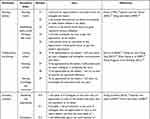 |
Table 3 Initial Items of Employee Zhengchong Behaviour |
Results of the Scale Development
Exploratory Factor Analysis
Questionnaire Recovery and Sample Collection
To apply exploratory factor analysis to confirm the items and conceptual structure of the employee zhengchong behaviour scale, a questionnaire was designed, and the first questionnaire survey was conducted. The Likert 5-point scale was adopted. The survey chose a professional platform for the data collection questionnaire survey, and the sample selection was mainly based on two standards. The samples were located in Jiangsu Province, and the samples were all family firms.
From September to October 2020, 320 questionnaires were randomly distributed and recovered. After eliminating invalid questionnaires, 278 valid questionnaires were obtained, and the effective questionnaire recovery rate was 86.88%. The survey’s analysis results of demographic variables are shown in Table 4. Among the 278 subjects, the ratio of males to females was similar, with 129 males (46.4%) and 149 females (53.6%). The age distribution was relatively wide, among which the 26- to 30-year-old cohort was the most common, accounting for 131 participants (47.1%), followed by the 31- to 35-year-old cohort, with 95 people (34.2%); more than half of the participants finished undergraduate college, with 230 people (82.7%); and 132 people had worked in the company for more than 5 years, accounting for 47.5%.
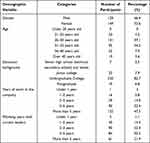 |
Table 4 Characteristics of Participants in Exploratory Factor Analysis |
Reliability Test and Project Purification
Preliminary reliability testing of the scale and item purification were carried out before exploratory component analysis of the data was performed, with Cronbach’s coefficient and CITC values of each item being examined to judge internal consistency and single-overall correlation. As shown in Table 5, the total Cronbach’s coefficient of the 20 items in the initial scale of employee zhengchong behaviour is 0.907, and the CITC values of the 20 items and the results of the α coefficient after deleting items are shown in Table 6. According to the experience standard, items with an α coefficient greater than 0.6 and a CITC index not less than 0.5 should be retained. The CITC index of Items S2, S14, and S20 are lower than 0.5, and the total α coefficient of the scale is improved after the deletion of Items S2 and S14, but the total α coefficient of the scale is unchanged after the deletion of Item S20. After a comprehensive investigation, Items S2, S14, and S20 are deleted based on simplifying the scale.
 |
Table 5 Results of the Internal Consistency Reliability Test of the Zhengchong Behaviour Scale |
 |
Table 6 Results of Exploratory Factor Analysis of Employee Zhengchong Behaviour |
Exploratory Factor Analysis
First, the applicability of exploratory factor analysis was tested on the sample data. With the help of SPSS software, the KMO and Bartlett’s test of the sample data were carried out, and the results showed that the KMO value was 0.876, which exceeded the critical empirical value of 0.7, indicating that there were many common factors in the sample data. The χ2 value of Bartlett’s test is 2929.005, which is significant (p<0.001), indicating common factors among the correlation matrices of the data. In conclusion, the sample data can be used for the subsequent factor analysis.
Second, according to Floyd & Widaman’s suggestions,28 the principal component method extracts By removing items that do not meet the relevant standards, a factor structure with significant theoretical significance and value can be obtained. Items are screened according to three main criteria: first, items must have a high load value on a specific factor; second, items must not have a high cross load on different factors; third, items must have a consistent connotation under a given factor. Based on factor analysis, item S5 has a high cross load across two factors, and this is contrary to the connotations of other items in the main factors, so it is necessary to delete this item and run factor analysis again. According to the four dimensions of employee zhengchong behavior, four factors are eventually extracted following the continuous factor analysis. A 73.949% contribution rate from the four factors is ideal for the total variance. In Table 6, 16 entries are retained, and their load on the factor to which they belong is greater than 0.50, with small crossloads in other dimensions, forming a robust factor structure. According to the prior research, the four factors are showing abilities, collaborating and sharing, excluding outsiders, and ingratiating upwards.
Confirmatory Factor Analysis
Questionnaire Recovery and Sample Collection
Confirmatory factor analysis was carried out on the items and conceptual structure of the employee zhengchong behaviour measurement scale. A second questionnaire was designed, and the second questionnaire survey was conducted. The Likert 5-point scale was adopted. This survey also used the online anonymous survey platform. The research samples came from private enterprises in Jiangsu, Zhejiang, Shanghai, Guangdong, Beijing, and other places and were widely distributed. From November 2020 to January 2021, 380 questionnaires were randomly distributed, and 380 questionnaires were recovered. After eliminating invalid questionnaires, 331 valid questionnaires were obtained, and the recovery rate of valid questionnaires was 87.11%. The analysis results of the demographic variables of the survey samples are shown in Table 7. Among the 331 subjects, the ratio of males to females was similar, with 162 males (48.9%) and 169 females (51.1%). The age distribution was relatively wide, among which the 26- to 30-year-old cohort was the most common, accounting for 182 participants (55.0%), followed by 31- to 35-year-old cohort, with 96 people (29.0%); more than half of the participants finished undergraduate college, with 273 people (82.5%); and 141 people had worked in the company for more than 5 years, accounting for 42.6%.
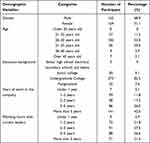 |
Table 7 Characteristics of Participants in Confirmatory Factor Analysis |
First-Order Confirmatory Factor Analysis
In this study, the structural equation model is built with the help of Amos 21.0 software to conduct confirmatory factor analysis on the sample data. The fitting situation of each nested model is shown in Table 8. Among the fitting index options, the fitting index of the four-factor model is best. It can be considered that the fitting index of the four-factor model has reached an ideal level, which shows that the four dimensions of showing abilities, collaborating and sharing, excluding outsiders, and ingratiating upwards have good distinguishing validity. The structure of the four-factor model is reasonable.
 |
Table 8 Results of Confirmatory Factor Analysis of Employee Zhengchong Behaviour |
The factor loading of the four-factor structural equation model is shown in Figure 2. From the figure, the standardized load coefficients of all the measurement items of employee zhengchong behaviour on the corresponding latent variables are higher than 0.5, and all of them pass the t test, which is significant at the level of p<0.001. This shows that the variables in this study have good aggregation validity and further verifies the rationality of the four-dimensional structure.
Second-Order Confirmatory Factor Analysis
The second-order model test results are shown in Figure 3. The path coefficients of the 4 dimensions, namely, showing abilities, collaborating and sharing, excluding outsiders, and ingratiating upwards, are all higher than the critical value of 0.7. Therefore, the researchers can consider that the inherent quality fitting degree of the second-order structural equation model of employee zhengchong behaviour is acceptable, and the four dimensions can better reflect the actual level of zhengchong behaviour.
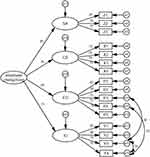 |
Figure 3 The results of second order confirmatory factor analysis of employee Zhengchong behaviour scale. |
In addition, each fitting index of the second-order structural model also reached the ideal level: χ2/df=1.580, RMSEA=0.037, GFI=0.964, PGFI=0.670, NFI=0.958, TLI=0.980, and CFI=0.984 (see Table 9). In summary, it can be concluded that the hypothesized four dimensions (showing abilities, collaborating and sharing, excluding outsiders, and ingratiating upwards) can better converge to the higher concept of employee zhengchong behaviour.
 |
Table 9 Reliability Coefficient of Employee Zhengchong Behaviour Scale |
Reliability and Validity Test of the Scale
Reliability Test
To analyse the reliability of the conceptual framework of employee zhengchong behaviour, the 331 valid sample data from the second survey were used to analyse the reliability of the 16 questions in the four dimensions, primarily by calculating each dimension’s Cronbach’s coefficient. According to common practice, Cronbach’s α coefficient of the scale is above 0.7, which signifies good reliability. As shown in Table 9, Cronbach’s α coefficients of the four dimensions of employee zhengchong behaviour are all more significant than 0.7, and the total Cronbach’s α coefficient of the scale is 0.916, which indicates that the scale has good reliability.
Validity Test
From the point of view of content validity, the generation of the employee zhengchong behaviour measurement scale in this study is based on extensive literature research and rooted in the analysis of interview data. After the first draft of the questionnaire was formed, aiming to make the measurement items more complete and targeted, relevant experts were invited to demonstrate and modify the expression of the items repeatedly, and employees were invited to try to fill in the feedback. Moreover, the initial questionnaire was formed through continuous modification and improvement. Meanwhile, many widely distributed sample data were randomly collected, and inappropriate items were further deleted by quantitative analysis. Therefore, judged on rationality, the content validity of the constructed employee zhengchong behaviour scale was appropriate in this study.
From the perspective of structural validity, the standardized load coefficients of the 16 items in the four dimensions of employee zhengchong behaviour are all higher than 0.5 (see Figure 3) and reach significant levels. The calculated average variance extracted (AVE) and composite reliability (CR) are shown in Table 10. The AVE values and CR values of the four factors of showing abilities, collaborating and sharing, excluding outsiders, and ingratiating upwards are all higher than 0.5 and 0.7, so it can be considered that the four-dimensional structure of employee zhengchong behaviour has good convergence validity. Table 11 shows the correlation coefficients among the four dimensions of employee zhengchong behaviour in this study. The maximum correlation coefficient is 0.556, far less than 0.85, which meets the standard, and each correlation coefficient among the four dimensions is less than the square root of the corresponding AVE. Therefore, the four dimensions of employee zhengchong behaviour have good discriminant validity. In summary, it can be concluded that the four-dimensional structure of employee zhengchong behaviour constructed in this study has good discriminant validity.
 |
Table 10 Convergence Validity Analysis of Employee Zhengchong Behaviour Scale |
 |
Table 11 Discriminatory Validity Analysis of Employee Zhengchong Behaviour Scale |
Research Discussion and Conclusions
Discussion
In this study, the researchers innovatively divide employee zhengchong behaviour into four specific dimensions, both positive and negative. Huang7 defined “zhengchong” as subordinates’ flattery, infighting, or collaboration of horizontal relationships to gain the leaders’ favour. Huang12 further divided zhengchong behaviour into four main dimensions: pleasing leaders and showing off, flattering and serving, suppressing competitors, and uniting others among enterprises. The above definition of “zhengchong” has a specific pejorative emotional colour. However, from the viewpoint of enterprise management practice, employee zhengchong behaviour does not contain only negative aspects. This paper divides zhengchong behaviour into four positive and negative dimensions based on in-depth interviews and ground theory. Positive zhengchong behaviour includes demonstrating abilities, collaborating, and sharing, while negative zhengchong behaviour includes excluding outsiders and ingratiating upwards.
Furthermore, this study developed a measurement scale of “employee zhengchong”. The researchers strictly followed the development steps of the scale and, based on exploratory factor analysis, constructed a 4-dimensional employee zhengchong behavior index system with 16 items, and passed the reliability test, which showed the items in each core category of the scale had a good consistency. Confirmatory factor analysis proved that the 4-dimensional structure of employee zhengchong behavior was the best. Combined reliability and mean-variance AVE method proved that the scale had good discrimination validity, conceptual validity and aggregation validity.
Theoretical Implications
Compared with previous studies, this study defines employee zhengchong behaviour more objectively and comprehensively, which provides a theoretical basis for further study of employee zhengchong behaviour and expands the relevant theoretical research on employee behaviour. In addition, this study innovatively develops the employee zhengchong behaviour scale. It provides an effective measurement tool for the quantitative research of “employee zhengchong behaviour.” The development of the employee zhengchong behaviour scale can offset the shortcomings of previous quantitative research on the role of employee zhengchong behaviour, promote the transformation of employee zhengchong behaviour from conceptual discussion to empirical analysis, and provide the possibility for further research on the mechanism of employee zhengchong behaviour.
Practical Implications
This study has important implications for enterprise practice; the following vital enlightenments are obtained:
- This study has deepened the understanding of enterprise managers on employee zhengchong behaviour and enabled them to form a more profound and more comprehensive cognition of “employee zhengchong behaviour.”
- The exploration of the structural dimension of employee zhengchong behaviour clarifies for leaders the basic content of each dimension of employee zhengchong behaviour, which can be used to guide leaders in piloting employees’ positive zhengchong behaviour in different dimensions and restraining employees’ negative zhengchong behaviour, thereby enhancing employees’ efficiency and laying foundations for the sustainable development of enterprises.
Conclusions
Based on the definitions of zhengchong by Taiwan scholars Huang Rui-xiang and Huang Guo-zhan, this study adopts the ground theory approach and conducts a pioneering in-depth study on employee zhengchong behaviour in the family firms of mainland China. This study focuses on the concept and measurement of employee zhengchong behaviour. For the concept of employee zhengchong behaviour, the structural dimensions are constructed, and then a corresponding scale for measuring employee zhengchong behaviour is developed. Furthermore, the clarification of the concept of employee zhengchong behaviour and the development of the scale in this paper provide not only a reference for further research but also important directions for family firm leaders to better apply differential management practices to promote positive employee attitudes and thus improve firm performance.
Ethics Statement
This study was carried out following the recommendations of the Ethical Principles of Psychologists and Code of Conduct by the American Psychological Association (APA). All participants gave written informed consent following the Declaration of Helsinki. The ethics committee approved the protocol of Jiangsu University, China.
Funding
This study is financed by the National Natural Science Foundation of China (72072076); The Postgraduate Research & Practice Innovation Program of Jiangsu Province (KYCX18_2213).
Disclosure
The authors declare that they have no conflicts of interest.
References
1. Tian ZL, Huang PL. Researches on leader-subordinate relation in Chinese organization: differential leadership. Sci Sci Manag S & T. 2013;34(4):150–157.
2. Erdogan B, Enders J. Support from the top: supervisors’ perceived organizational support as a moderator of leader-member exchange to satisfaction and performance relationships. J Appl Psychol. 2007;92(2):321–330. doi:10.1037/0021-9010.92.2.321
3. Fu Q, Cherian J, Ahmad N, et al. An inclusive leadership framework to foster employee creativity in the healthcare sector: the role of psychological safety and polychronicity. Int J Environ Res Public Health. 2022;19(8):4519. doi:10.3390/ijerph19084519
4. Westwood R. The cultural basis for paternalistic headship among the overseas Chinese. Organ Stud. 1997;18:445–480. doi:10.1177/017084069701800305
5. Wu LZ, Yim FH, Kwan HK, et al. Coping with workplace ostracism: the roles of ingratiation and political skill in employee psychological distress. J Manag Stud. 2012;49(1):178–199. doi:10.1111/j.1467-6486.2011.01017.x
6. Jiang DY, Cheng BS. Affect- and role-based loyalty to supervisors in Chinese organizations. Asian J Soc Psychol. 2008;11(3):214–221. doi:10.1111/j.1467-839X.2008.00260.x
7. Huang RX. Competing for favor: the game of thrones for Chinese subordinates. Institute of Psychology, National Taiwan University; 2009.
8. Shi QQ. Opinion on family business, internal control and corporate governance——taking true Kung Fu as an example. Enterp Reform Manag. 2017;16:50. doi:10.13768/j.cnki.cn11-3793/f.2017.3154
9. Abdullah MI, Huang D, Sarfraz M, et al. Signifying the relationship between counterproductive work behavior and firm’s performance: the mediating role of organizational culture. Bus Process Manag J. 2021;27(6):1892–1911. doi:10.1108/BPMJ-12-2020-0546
10. Sarfraz M, Ivascu L, Ozturk I. Why does abusive leadership lead to employee silence? The mediating role of perceived insider status and psychological safety. Int J Work Organ Emotion. 2021;12(3):268–282. doi:10.1504/IJWOE.2021.118998
11. Xu WD. A case study of “Fang Tai Confucianism and Taoism” humanistic management——Based on the perspective of corporate governance. Chin Prices. 2021;11:96–98.
12. Huang GZ. Differential leadership and employee favoritism. Chung Cheng University; 2014.
13. Ferris GR, Treadway DC, Kolodinsky RW, et al. Development and validation of the political skill inventory. J Manag. 2005;31(1):126–152. doi:10.1177/0149206304271386
14. Sun J, Sarfraz M, Khawaja KF, et al. The perils of the pandemic for the tourism and hospitality industries: envisaging the combined effect of COVID-19 fear and job insecurity on employees’ job performance in Pakistan. Psychol Res Behav Manag. 2022;15:1325–1346. doi:10.2147/PRBM.S365972
15. Mohsin M, Jamil K, Naseem S, et al. Elongating nexus between workplace factors and knowledge hiding behavior: mediating role of job anxiety. Psychol Res Behav Manag. 2022;15:441–457. doi:10.2147/PRBM.S348467
16. Strauss AL, Glaser BG. The Discovery of Grounded Theory: Strategiesfor Qualitative Research. Chicago: Aldine Publishing Company; 1967.
17. Chen XM. Ideas and methods of the grounded theory. Edu Res Exper. 1999;4:58–63+73.
18. Kumar K, Beyerlein M. Construction and validation of an instrument for measuring ingratiatory behaviors in organizational settings. J Appl Psychol. 1991;76(5):619–627. doi:10.1037/0021-9010.76.5.619
19. Janssen O, Van Yperen NW. Employees’ goal orientations, the quality of leader-member exchange, and the outcomes of job performance and job satisfaction. Acad Manag J. 2004;47(3):368–384. doi:10.5465/20159587
20. Gong Y, Huang JC, Farh JL. Employee learning orientation, transformational leadership, and employee creativity: the mediating role of employee creative self-efficacy. Acad Manag J. 2009;52(4):765–778. doi:10.5465/AMJ.2009.43670890
21. Farh JL, Zhong CB, Organ DW. Organizational citizenship behavior in the People’s Republic of China. Organ Sci. 2004;15(2):241–253. doi:10.1287/orsc.1030.0051
22. Wang H, Chang Y. The influence of organizational innovation atmosphere and work motivation on employees’ innovative behavior. Manag Sci. 2017;30(03):51–62.
23. Zhao XP, Zhou M, Li J, et al. An empirical study on the characteristics of potential competence of software engineers. Res Manag. 2007;05:110–114+75.
24. Wang XY, Ji ZH. Research on the relationship between knowledge heterogeneity and performance of interdisciplinary innovation teams. Res Manag. 2013;34(03):14–22.
25. Einarsen S, Hoel H, Notelaers G. Measuring exposure to bullying and harassment at work: validity, factor structure and psychometric properties of the negative acts questionnaire-revised. Work Stress. 2009;23(1):24–44. doi:10.1080/02678370902815673
26. Ferris DL, Brown DJ, Berry JW, et al. The development and validation of the workplace ostracism scale. J Appl Psychol. 2008;93(6):1348–1366. doi:10.1037/a0012743
27. Bolino MC, Turnley WH. Measuring impression management in organizations: a scale development based on the jones and pittman taxonomy. Organ Res Methods. 1999;2(2):187–206. doi:10.1177/109442819922005
28. Floyd FJ, Widaman KF. Factor analysis in the development and refinement of clinical assessment instruments. Psychol Assess. 1995;7(3):286–299. doi:10.1037/1040-3590.7.3.286
 © 2022 The Author(s). This work is published and licensed by Dove Medical Press Limited. The full terms of this license are available at https://www.dovepress.com/terms.php and incorporate the Creative Commons Attribution - Non Commercial (unported, v3.0) License.
By accessing the work you hereby accept the Terms. Non-commercial uses of the work are permitted without any further permission from Dove Medical Press Limited, provided the work is properly attributed. For permission for commercial use of this work, please see paragraphs 4.2 and 5 of our Terms.
© 2022 The Author(s). This work is published and licensed by Dove Medical Press Limited. The full terms of this license are available at https://www.dovepress.com/terms.php and incorporate the Creative Commons Attribution - Non Commercial (unported, v3.0) License.
By accessing the work you hereby accept the Terms. Non-commercial uses of the work are permitted without any further permission from Dove Medical Press Limited, provided the work is properly attributed. For permission for commercial use of this work, please see paragraphs 4.2 and 5 of our Terms.

